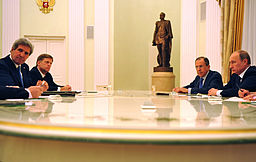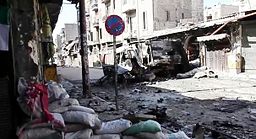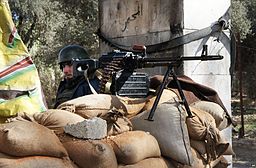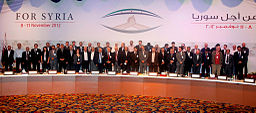(Updated 22 May 2013) Now that we know and understand better the actors present on the Syrian battlefield, we may start outlining scenarios regarding first plausible futures for Syria and prospects for peace over the short to medium term, and second the regional implications of those scenarios, as the regional and even global geostrategic dimensions of the war in Syria are becoming clearer everyday.
Scenario 1: Negotiating Peace for Syria in Geneva
The diplomatic talks promoting a negotiated settlement of the Syrian civil war are successful and negotiations start.
Sub-scenario 1.1.: All but the Jihadis
The actors brought around the table are the NC and the Supreme Joint Military Command Council (SMC), the regime of Bashar al-Assad represented by a face-saving person for the regime and a person that would be acceptable to all other parties (assuming such a person exist), the Supreme Kurdish Council (SKC) and the Salafi-Nationalist groups.
Sub-scenario 1.1.1.: A fragile Syrian external peace
An external peace can be brokered. We would have a very fragile peace including all actors except those fighting for a global Jihad. Considering the current level of escalation and the intentions of the most extremist factions, if we want to increase the likelihood to see a real positive peace – corresponding to many Western countries’ declared foreign policy vision, upholding the rule of law and human rights – last, then we need to make sure that the following elements are included: a strong presence and support of the international community (despite the public deficit challenge mentioned above), a properly devised strategic plan and real actions rather than unrealistic pledges that are inherently escalating when what must be stopped is also the “people”s war” efficient policy of the extremist factions.
Timing would also be of the essence once the peace is brokered, as speed and real efficiency are crucial. Notably, and considering the heightened sensitivity of a people having had to go through a civil war, as well as the religious environment, corruption and various dysfunctions within the peace-building intervening system, should be avoided.
It would thus be crucial to start working towards a proper plan to construct the peace as soon as possible, using all bilateral and multilateral cooperation channels. To make sure the peace-building process is properly implemented, actionable early warning and monitoring systems should be planned and constructed from the start.
The next five to ten years would remain a very delicate period with heightened risks of re-escalation towards war.
Sub-scenario 1.1.2.: Back to civil war – Jihadis’ advantage?
The negotiations fail and Syria falls again into civil war, but with changed conditions: the failure will have a price for each actor involved, according to the reasons for and conditions surrounding the failure. The global-jihadi groups would most probably benefit most.
Sub-scenario 1.2.: All but the Salafis
The actors brought around the table are the NC and the SMC, the regime of Bashar al-Assad represented by a face-saving person for the regime and a person that would be acceptable to all other parties (assuming such a person exist) and the SKC.
The Salafi-Nationalist groups (all or most of them), even those having linked to the SMC, would refuse to participate in the negotiations.
Sub-scenario 1.2.1.: An unlikely very fragile external peace
The negotiations succeed. The external peace that is brokered is even more fragile. The prospects for successfully implementing it would be greatly reduced. All the risks already present in the previous sub-scenario (1.1.1) would be heightened. With a level of power (resources, troops and actions) constant compared with sub-scenario 1.1.1., the likelihood of success would be inversely proportional to the policy and actions of the Salafi-Nationalist groups, ranging from only refusing to participate in the negotiations and settlement to actively denouncing and fighting them. To increase the likelihood of success, the level of power applied would have to be proportionally enhanced and the length of time during which this power would be necessary would have to be increased. In other words, more troops and more civilian personal, as well as more resources would have to be dedicated to Syria for longer.
Sub-scenario 1.2.2.: Back to civil war – Salafis’ advantage?
The negotiations fail and Syria is dragged again into civil war.
Scenario similar to 1.1.2 but with a very strong advantage for the Salafi groups, be they nationalist or jihadi.
Estimating Likelihood for Scenario 1
What could enhance the likelihood to see such a scenario happening? What are the supporting facts increasing the plausibility of scenario 1?
- The civil war in Syria drags on, with specific evolution and dynamics over the winter 2012/2013 favouring diplomatic talks between international powers (see end of last post);
- Fear by external actors to see further use and spread of chemical weapons,
- Heightened fear by external actors to see the Syrian conflict spilling over further, which was bound to happen considering its regional and global dimension, supported notably by the Al Qaeda nexus April statements, by the declarations of Hassan Nasrallah, leader of the Lebanese Hezbollah acknowledging his group fights besides the regime of Bashar al-Assad (Black and Roberts, The Guardian, 30 April 2013), by the 3 and 5 May Israeli attacks on Syria (e.g. interesting analysis by Ben Caspit, 5 May 2013, AlMonitor), then by the 11 May 2013 terror attack on the Turkish town of Reyhanli, (Daloglu, 12 May 2013 AlMonitor), the latter linking too to the refugees issue and its destabilizing dimension for neighbouring countries.
- Difficulty to implement rapidly, efficiently and with a high likelihood of success any other solution. Lack of clear support in the domestic constituencies of potentially intervening countries, notably in the U.S., for those solutions, and possible polarisation of opinions, considering multiple diasporas and humanitarian disaster.
- Cost of intervention for intervening countries, considering the widespread problem of public deficits and the solutions usually chosen to face this challenge (reduction of public expenses and privatization of the state).
- Leading to Foreign Minister Sergei Lavrov and Secretary of State John Kerry announcement that Russia and The U.S. had agreed “to work towards convening an international conference to find a political solution to the conflict in Syria,” and thus to the continuation of diplomatic work in this direction (BBC, 7 May 2013), as well as to the ongoing diplomatic exchanges between concerned partied.
- Increased violence and multiplication of attacks – to a point – would not be an indication that talks will finally fail to bring about peace negotiations, nor that peace negotiations are breaking down, as actors will seek the strongest bargaining position possible at the negotiation table and this position is obtained through fighting. Renewed battles should be seen as (a dramatic) part of the overall negotiation process.
- Which Syrian actors must participate? Considering the diversity of actors on the ground, this point is particularly delicate, crucial and will most probably lead to many discussions, declarations, bargains and twists, as the two declarations below let us expect.
- Moaz Al-Khatib, ex-President of the National Coalition for Syrian Revolutionary and Opposition Forces (NC) suggested “We refuse any radical thinking but this does not mean we can exclude them, they are Syrians and they have the right to speak up, and we need to enter into a dialogue with them. They are Syrians and for me a Syrian is worth more than the whole world” (Phil Sands, The National, May 9, 2013). It is most likely that an official participation by Salafi-Jihadi groups will be rejected by international powers as well as by part of the NC factions, however covert dialogue could take place between Syrian some actors. The question could also be asked for Salafi-Nationalist groups.
- The surprising declaration by “Abdul Qader Saleh, commander of the Al-Tawhid Brigade,” member of the Syrian Liberation Front to “the Turkish news agency Cihan” accusing Israel to have destroyed weapons that were about to be seized by “the rebellion” and not arms that were about to reach the Hezbollah, thus to side with Iran and the Hezbollah to support Assad (Ynet, 13 May 2013) could signal an early hardening of the SLF (which had been suggested as possible by Lund, 2013: 27). This declaration might in turn prepare the ground for refusing the potential negotiations or for building a stronger bargaining position.
Scenario 2: No Syrian in Geneva
The diplomatic talks fail … to be continued.
——
Detailed bibliography and primary sources forthcoming.






